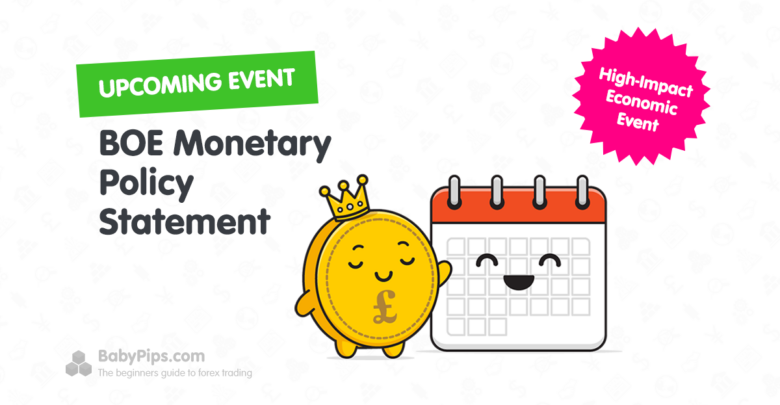
The BOE decision is comin’ right up!
Are they in for a “dovish hike” like some of their central bank peers?
Here’s what the U.K. central bank might have up its sleeve and how pound pairs might react.
Event in Focus:
Bank of England Monetary Policy Statement for August 2023
When Will it Be Released:
August 3, Thursday: 11:00 am GMT
Use our Forex Market Hours tool to convert GMT to your local time zone.
Expectations:
- BOE to hike interest rates by 0.25% from 5.00% to 5.25%
- MPC to vote 7-2 in favor of tightening vs. holding
- No change to asset purchases expected
Yet another 0.25% interest rate hike is on the docket for the BOE this week, likely marking their fourteenth (and counting?) consecutive tightening move and bringing the benchmark rate up from 5.00% to 5.25%.
The minutes of their policy meeting are due around the same time as the announcement, which would shed more light on their decision and probably have clues on whether or not they’d be able to extend their rate hikes past this month.
Just as in their previous decisions, a couple of dovish dissenters are likely to vote for no change in the benchmark rate while the rest are likely to push for an increase.
However, an increase in votes to keep rates on hold may mark a significant shift in the BOE’s policy bias.
Relevant U.K. Data Since the Last BOE Statement:
? Arguments for Hawkish Monetary Policy / Bullish GBP
June retail sales accelerated from 0.1% m/m uptick to 0.7% growth, outpacing projected 0.2% increase in consumer spending
May GDP reading showed a smaller than expected 0.1% m/m contraction vs. projected 0.3% reduction in growth, following April’s 0.2% expansion
Average earnings index for three-month period ending in May came in at 6.9% vs. earlier 6.7% figure and 6.8% consensus, suggesting sticky wage pressures
? Arguments for Dovish Monetary Policy / Bearish GBP
July Markit flash manufacturing PMI slipped from 46.5 to 45.0 vs. 46.1 consensus, flash services PMI down from 53.7 to 51.5 vs. 53.1 forecast
June headline CPI tumbled from 8.7% y/y to 7.9% vs. 8.2% consensus, core figure down from 7.1% y/y to 6.9% instead of staying unchanged
June claimant count change reflected 25.7K increase in joblessness vs. estimated 20.5K gain, earlier reading upgraded to show 22.5K decrease in unemployment from initially reported 13.6K reduction
Previous Releases and Risk Environment Influence on GBP
June 22, 2023
Action / results:
Sterling was on weak footing prior to the BOE decision, as stronger than expected U.K. inflation data prompted speculations that more aggressive tightening moves could bring the economy closer to a recession.
Still, the BOE took the markets by surprise when they announced a 0.50% interest rate hike instead of the widely-expected 0.25% increase.
Because of that, the pound managed to recoup some its post-CPI losses and even extended its gains when the U.K. economy printed strong consumer sector data, which soothed investors’ growth concerns.
Risk environment and Intermarket behaviors:
Hotter than expected inflation had been the prevailing market theme for the most part of the week, causing traders to worry about higher borrowing costs ramping up recession risks.
Risk-off flows were already in play after Goldman Sachs cut its growth forecasts for China while the China State Council announced vague economic support measures. It didn’t help that global flash PMI readings came in mostly weaker than expected on Friday, dragging higher-yielding assets further south.
May 11, 2023
Action / results:
As expected, the BOE hiked interest rates by 0.25% to 4.50% in a 7-2 split among MPC members. However, the event still turned out more hawkish than expected since the Monetary Policy Report featured upgrades to inflation forecasts.
To top it off, head honcho Bailey mentioned that “if there were to be evidence of more persistent [inflationary] pressures, then further tightening in monetary policy would be required.”
The bullish tide turned when Bailey mentioned in an interview after the presser that they are nearing a point when the central bank could “rest in terms of the level of rates.”
Later in the week, a downbeat U.K. monthly GDP reading fueled expectations of a tightening pause down the line.
Risk environment and Intermarket behaviors:
Strong risk appetite from the previous trading week spilled over and allowed for a positive start among higher-yielding assets.
This didn’t last long, though, as the spotlight returned to U.S. debt ceiling woes and some hints of caution among central bankers. Downbeat data from China also rolled in, followed by reports of a deposit run in a U.S. regional bank, extending the selloff for risk assets.
Price action probabilities
Risk sentiment probabilities:
Some risk-on flows can be observed early this week, following mixed PMI readings from China spurring expectations of more stimulus from the government and central bank.
Sentiment leading up to the BOE event on Thursday might still be impacted by the RBA’s decisions to hold off of a rate hike, as well as a handful of leading U.S. jobs indicators that could influence global interest rate expectations.
So far it looks like market watchers are counting on a less aggressive pace of tightening among most major central banks, with upside data surprises and hawkish rhetoric keeping traders on their toes in regards to potential recessionary conditions ahead.
British pound scenarios
Potential base case:
U.K. economic data has been more or less balanced in the past month, as inflationary pressures continue to subside while the consumer sector is looking robust.
This could make the case for a less-hawkish-than-usual BOE announcement, possibly similar to their May 2023 decision where they toned down their forward guidance.
More policymakers voting to keep rates on hold this time might even spell downside for the pound, as a “dovish hike” would signal that the U.K. central bank is nearing the end of its tightening spree.
In this case, look out for a possible GBP selloff against currencies whose central banks are sticking to a hawkish stance like the Fed and SNB, especially if risk-off flows remain in play during the latter half of the week.
Don’t forget to keep an eye out for the U.S. ISM manufacturing PMI, ADP jobs data, and JOLTS job openings to gauge if upbeat NFP expectations can prop up the dollar or influence broad risk sentiment.
Potential alternative scenario:
Resilience in the U.K. economy might give BOE head Bailey and his fellow policymakers more confidence that they can carry on with their rate hikes without putting overall growth at risk.
Keep in mind that headline inflation is still waaay above the central bank’s target, so they have a lot of work to do when it comes to driving down stubborn price pressures.
If the BOE hints that they are not looking to pause tightening anytime soon, this might make the U.K. central bank the most hawkish one among its peers, possibly spurring a sharp sterling rally.
In particular, GBP could climb against currencies with more dovish central banks, especially against EUR since the ECB just shifted to a more cautious stance recently.
If the RBA decides to go the “dovish hike” route as well or if New Zealand’s quarterly jobs data disappoints, there could be opportunities to buy the pound against the Aussie and Kiwi, too.









